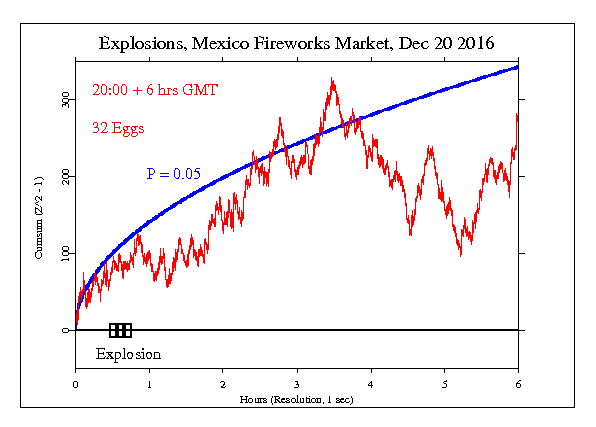Mexico Fireworks Market Explosion
Tultepec, Mexico (CNN)
For years, families have wandered through rows of stalls at San Pablito, searching for fireworks to launch during holiday season celebrations.
At least 33 people were killed and dozens more were injured in a massive series of explosions Tuesday at this market north of Mexico City, officials said. The powerful, deadly blasts sent huge plumes of smoke billowing into the sky and shook the ground in neighboring towns. The bodies of 28 people who died have been identified and returned to their relatives. Authorities say it could be another few days before they can determine the identities of the other five victims. The governor of the state of Mexico, Eruviel Ávila Villegas, instructed his administration to assist in the costs of funerals.
Specific Hypothesis and Results
The GCP event beginning was set for Tuesday, Dec 20, "somewhat before 3 pm" local time, specifically at 2:00 pm local time, which is 20:00 UTC. The standard 6 hour period ended at 02:00 UTC on the 21st. The result is Chisquare 21889 on 21600 df, for p = 0.083 and Z = 1.385.
Interpretation
The following graph is a visual display of the statistical result. It shows the second-by-second accumulation of small deviations of the data from what’s expected. Our prediction is that deviations will tend to be positive, and if this is so, the jagged line will tend to go upward. If the endpoint is positive, this is evidence for the general hypothesis and adds to the bottom line. If the endpoint is outside the smooth curve showing 0.05 probability, the deviation is nominally significant. If the trend of the cumulative deviation is downward, this is evidence against the hypothesis, and is subtracted from the bottom line. For more detail on how to interpret the results, see The Science and related pages, as well as the standard caveat below.

Standard caveat
It is important to keep in mind that we have only a tiny statistical effect, so that it is always hard to distinguish signal from noise. This means that every success
might be largely driven by chance, and every null
might include a real signal overwhelmed by noise. In the long run, a real effect can be identified only by patiently accumulating replications of similar analyses.
